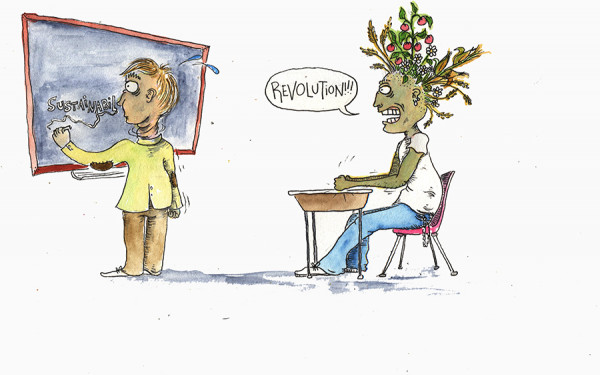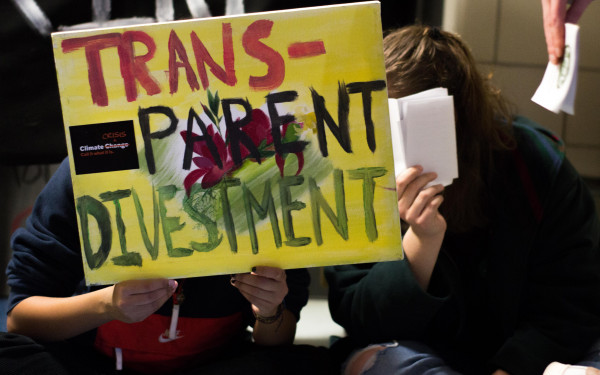Making the Economy More Environmentally-Friendly
Experts Discuss Ways of Curbing Biodiversity Loss by 2020
Are capitalism and environmental protection compatible?
On Oct. 3, Concordia’s David O’Brien Centre for Sustainable Enterprise hosted a panel discussion on biodiversity and business at the John Molson School of Business.
A panel of experts discussed solutions to biodiversity loss, presenting strategies based on the implementation of the 2011-2020 United Nations Decade on Biodiversity plan.
It was the first of three panel discussions being held at Montreal universities in association with the United Nations Secretariat for the Convention on Biological Diversity’s 20/20 Talks on the Aichi Biodiversity Targets—a set of goals aiming to tackle the underlying causes of biodiversity loss by 2020.
Among the panellists were Paul Shrivastava, a professor of sustainable enterprise at Concordia and the director of the David O’Brien Centre; Peter Kevan, a professor of environmental biology and applied ecology at the University of Guelph; Claudia Ituarte-Lima of the Stockholm Resilience Centre at Stockholm University; Rajendra Dobriyal, a senior regulatory affairs manager at Hindustan Unilever Ltd. in India; and Claude Fromageot, the director of sustainable development for the Yves Rocher Group.
“The mainstream economy is not biodiversity-friendly,” said Shrivastava at the discussion. “We need alternative capitalism models that are biodiversity-friendly. [What] would a biodiversity-friendly economy look like?”
Shrivastava spoke about the success story of the Echigo-Tsumari Art Field, an experimental regional development in Echigo-Tsumari, Japan, aiming to bring people back into the city and to revitalize the local economy.
The field features various artworks displayed outdoors, connecting visitors with the history of the city and its landscape. Moreover, it’s run locally under a corporate structure and with the help of global volunteerism.
Art can serve as a driving tool of development and can also help revive community-owned economies for the sake of their “living culture” and not just profits, said Shrivastava.
“[It] is not about making money [but] about recovering memory,” Shrivastava said, explaining how the project has become financially independent by embracing this notion. Shrivastava says the Art Field welcomes over one million visitors annually, creating over 700 jobs in the region and 7,000 volunteer positions per month.
Kevan spoke about sustainable agriculture through the example of pollination. He alluded to agriculture as the “major destructor of biodiversity” due to its dependency on chemical pesticides and fertilizers to keep up with market demand worldwide.
According to his research, bees can be the solution.
“The bee-keeping industry [can] encourage pollinators in agro-ecosystems,” Kevan said.
He went on to explain that bees can be used in pest control by transmitting specific bacteria and viruses to pests, thus helping to prevent their populations from growing.
This process, known as pollinator biocontrol vector technology, has already been implemented in coffee plantations in Mexico and Brazil, where it has proved to be effective at minimizing labour costs, among other things. Kevan said he’s concerned, however, that many farmers don’t acknowledge the importance of pollinator use, prolonging the use of chemical sprays.
As for sustaining biodiversity on a larger scale, Ituarte-Lima said there needs to be a “broader perspective in defining rights and duties for reconciling biodiversity conservation in various ecosystems and people’s livelihoods.”
“Procedural safeguards [should] involve a shift of perspective from static provisions in laws to resilient and locally rooted safeguards that are supported by country-driven processes that make use of existing international legal and policy instruments,” she said.
The representatives from Unilever and Yves Rocher emphasized the efforts of their companies to help accomplish the Aichi goals. The engagement of the community with holistic approaches, the reduction of greenhouse gas emissions and the use of sustainably sourced raw materials were mentioned as feasible examples of how businesses can help protect the environment and stem biodiversity loss.
“The United Nations is at least recognizing things must change if we want to preserve some of the natural beauty this planet shelters,” said Amanda Robles, an undergraduate student in psychology who was present at the panel discussion, attended by about 24 other people.
“It is now our responsibility as the next generation of leaders to take it to the next level. If we want to continue capitalizing from consumerism, we must let go of some unhealthy principles,” she continued.
The second event in the series will take place at HEC Montréal’s Decelles Building on Oct. 8, and will discuss traditional knowledge and biodiversity. McGill University will host the third session in the Redpath Museum on Oct. 15, which will focus on the theme of science and biodiversity.

_900_467_90.jpg)
2_900_597_90.jpg)
_600_832_s.png)

_600_375_90_s_c1.jpg)


